ignition Citroen C4 CACTUS RHD 2015 1.G Owner's Guide
[x] Cancel search | Manufacturer: CITROEN, Model Year: 2015, Model line: C4 CACTUS RHD, Model: Citroen C4 CACTUS RHD 2015 1.GPages: 326, PDF Size: 8.56 MB
Page 116 of 326
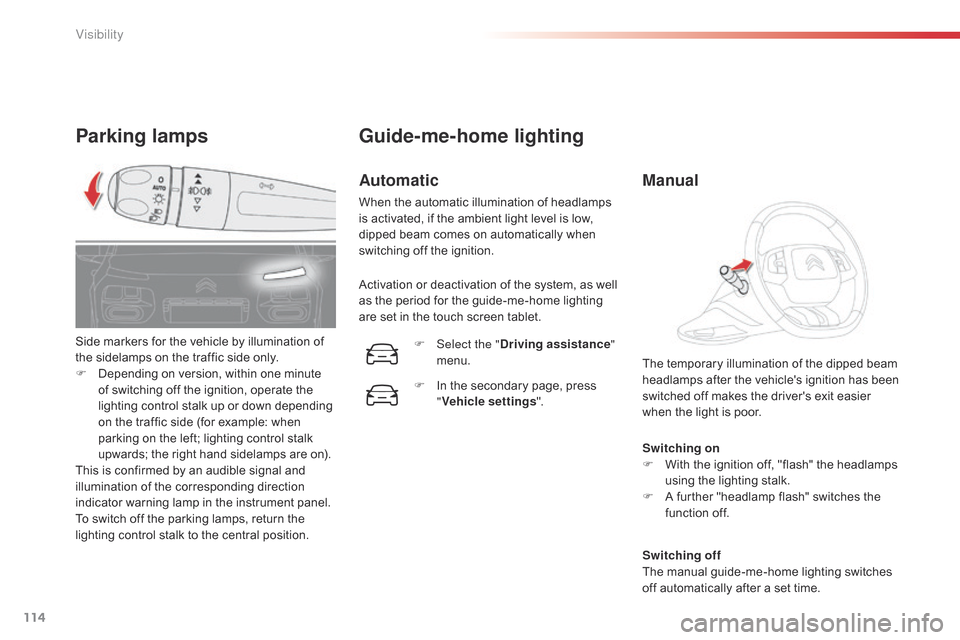
114
Parking lamps
Switching on
F W ith the ignition off, "flash" the headlamps
u
sing the lighting stalk.
F
A
further "headlamp flash" switches the
f
unction off.
Switching off
The
manual guide-me-home lighting switches
o
ff automatically after a set time.
The
temporary illumination of the dipped beam
h
eadlamps after the vehicle's ignition has been
s
witched off makes the driver's exit easier
w
hen the light is poor.
Side
markers
for
the
vehicle
by
illumination
of
t
he
sidelamps
on
the
traffic
side
only.
F
D
epending
on
version,
within
one
minute
o
f
switching
off
the
ignition,
operate
the
l
ighting
control
stalk
up
or
down
depending
o
n
the
traffic
side
(for
example:
when
p
arking
on
the
left;
lighting
control
stalk
u
pwards;
the
right
hand
sidelamps
are
on).
This
is
confirmed
by
an
audible
signal
and
i
llumination
of
the
corresponding
direction
i
ndicator
warning
lamp
in
the
instrument
panel.
To
switch
off
the
parking
lamps,
return
the
l
ighting
control
stalk
to
the
central
position.
Guide-me-home lighting
Automatic
When the automatic illumination of headlamps i s activated, if the ambient light level is low,
d
ipped beam comes on automatically when
s
witching off the ignition.
Activation
or deactivation of the system, as well
a
s the period for the guide-me-home lighting
a
re set in the touch screen tablet.
F
Sel
ect the "Driving assistance "
menu.
F
I
n the secondary page, press
"V
ehicle settings".
Manual
Visibility
Page 122 of 326
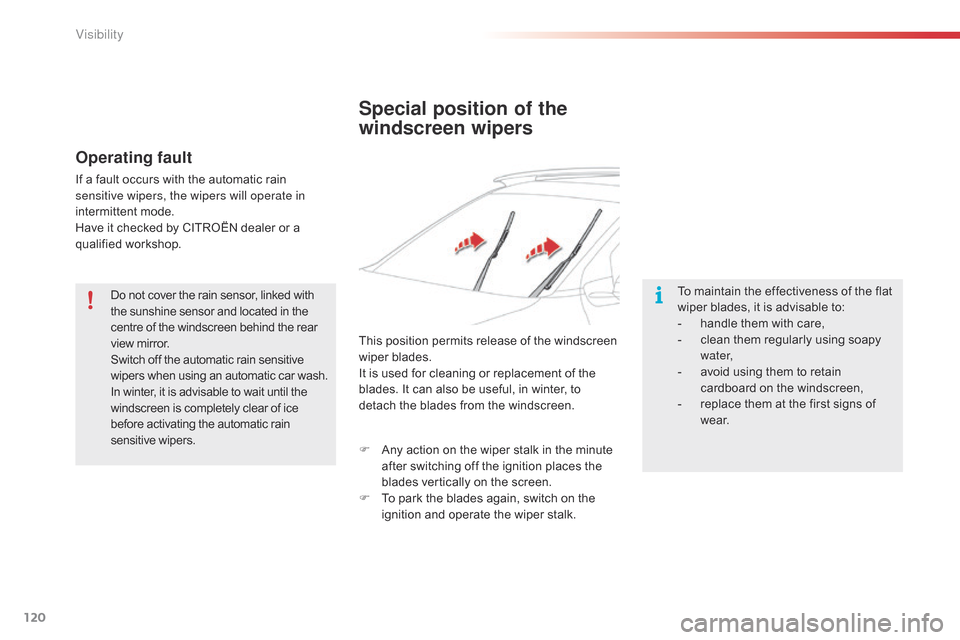
120
Special position of the
windscreen wipers
To maintain the effectiveness of the flat wiper blades, it is advisable to:
-
h
andle them with care,
-
c
lean them regularly using soapy
w
ater,
-
a
void using them to retain
c
ardboard on the windscreen,
-
r
eplace them at the first signs of
w
e a r.
This
position
permits
release
of
the
windscreen
w
iper
blades.
It
is
used
for
cleaning
or
replacement
of
the
b
lades.
It
can
also
be
useful,
in
winter,
to
d
etach
the
blades
from
the
windscreen.
Do
not
cover
the
rain
sensor,
linked
with t
he
sunshine
sensor
and
located
in
the
c
entre
of
the
windscreen
behind
the
rear
v
iew
mirror.
Switch
off
the
automatic
rain
sensitive
w
ipers
when
using
an
automatic
car
wash.
In
winter,
it
is
advisable
to
wait
until
the
w
indscreen
is
completely
clear
of
ice
b
efore
activating
the
automatic
rain
sen
sitive
w
ipers.
Operating fault
If a fault occurs with the automatic rain s ensitive wipers, the wipers will operate in
intermittent
mode.
Have
it checked by CITROËN dealer or a
q
ualified
w
orkshop.
F
A
ny action on the wiper stalk in the minute
a
fter switching off the ignition places the
b
lades vertically on the screen.
F
T
o park the blades again, switch on the
i
gnition and operate the wiper stalk.
Visibility
Page 124 of 326
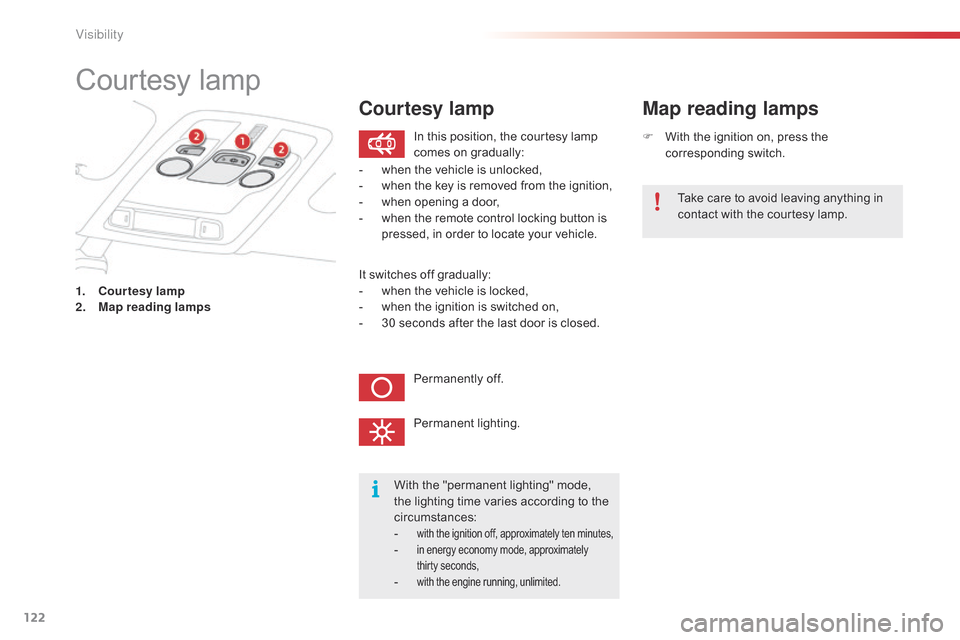
122
Courtesy lamp
1. Courtesy lamp
2. M
ap reading lamps F
W
ith the ignition on, press the
c
orresponding
s
witch.
Map reading lamps
With the "permanent lighting" mode, t
he lighting time varies according to the
c
ircumstances:
-
with the ignition off, approximately ten minutes,- in energy economy mode, approximately t
hirty seconds,
- with the engine running, unlimited.
In this position, the courtesy lamp c
omes on gradually:
Permanently
off.
Permanent
l
ighting.
-
w
hen
the vehicle is unlocked,
-
w
hen
the key is removed from the ignition,
-
w
hen
opening a door,
-
w
hen
the remote control locking button is
p
ressed, in order to locate your vehicle.Take
care to avoid leaving anything in
c
ontact with the courtesy lamp.
Courtesy lamp
It switches off gradually:
- w hen the vehicle is locked,
-
w
hen the ignition is switched on,
-
3
0 seconds after the last door is closed.
Visibility
Page 125 of 326
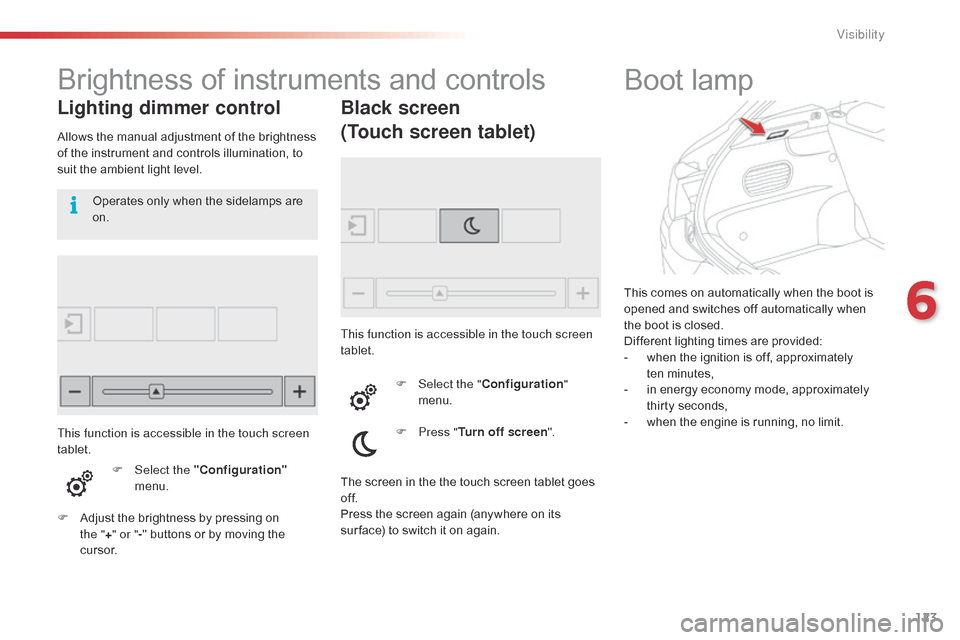
123
This comes on automatically when the boot is opened and switches off automatically when
t
he boot is closed.
Different
lighting times are provided:
-
w
hen the ignition is off, approximately
t
en minutes,
-
i
n energy economy mode, approximately
t
hirty seconds,
-
w
hen the engine is running, no limit.
Boot lamp
Brightness
of
instruments
and
controls
Lighting dimmer control
Allows the manual adjustment of the brightness o
f the instrument and controls illumination, to
s
uit the ambient light level.
F
Sel
ect the "Configuration"
menu.
F
A
djust the brightness by pressing on
t
he "+ " or " -"
buttons or by moving the
c
u r s o r.Operates
only when the sidelamps are
o
n.
Black screen
(Touch screen tablet)
This function is accessible in the touch screen
tablet. F
Sel
ect the "Configuration "
menu.
F
P
ress "Turn off screen ".
This function is accessible in the touch screen
tablet.
The
screen in the the touch screen tablet goes
o
f f.
Press
the screen again (anywhere on its
s
ur face) to switch it on again.
6
Visibility
Page 126 of 326
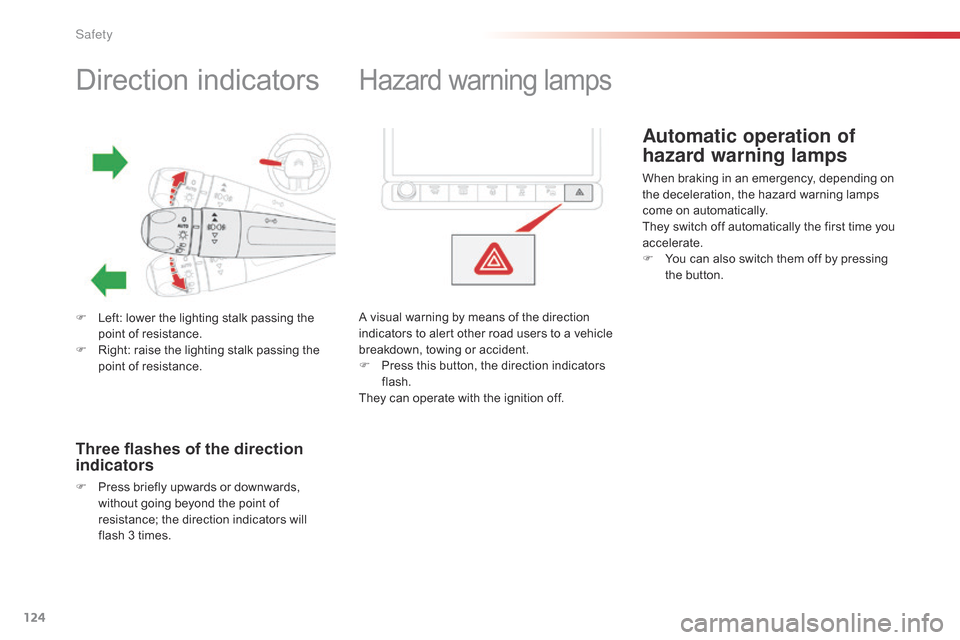
124
Direction indicators
F Left: lower the lighting stalk passing the p
oint of resistance.
F
R
ight: raise the lighting stalk passing the
p
oint of resistance.
Three flashes of the direction
indicators
F Press briefly upwards or downwards, w
ithout going beyond the point of
r
esistance; the direction indicators will
f
lash 3 times.
Hazard warning lam ps
A visual warning by means of the direction i
ndicators to alert other road users to a vehicle
b
reakdown, towing or accident.
F
P
ress this button, the direction indicators
f
lash.
They
can operate with the ignition off.
Automatic operation of
hazard warning lamps
When braking in an emergency, depending on the deceleration, the hazard warning lamps
c
ome on automatically.
They
switch off automatically the first time you
a
ccelerate.
F
Y
ou can also switch them off by pressing
t
he button.
Safety
Page 130 of 326
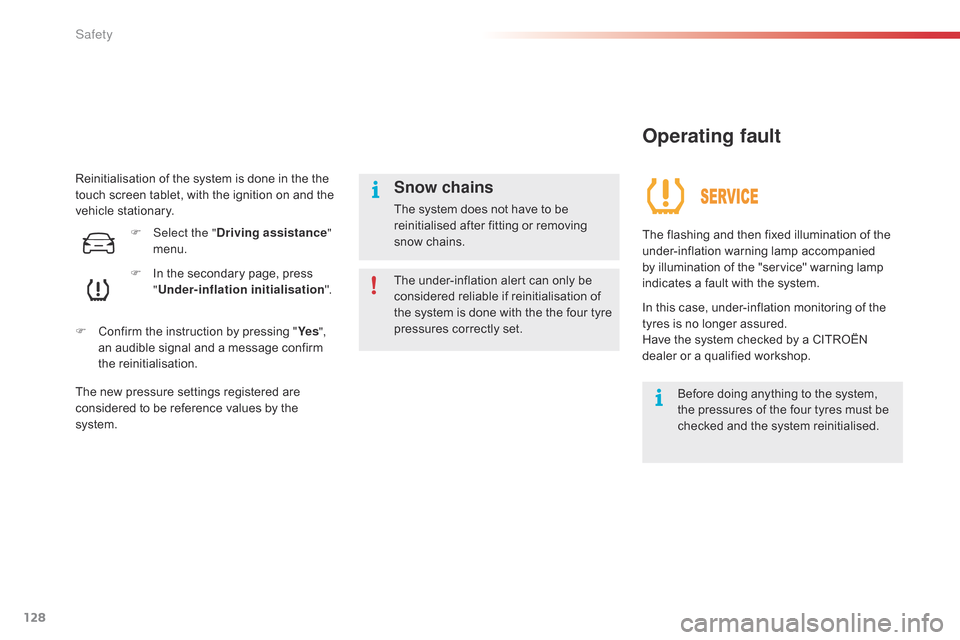
128
Reinitialisation of the system is done in the the touch screen tablet, with the ignition on and the
v
ehicle stationary.
F
I
n the secondary page, press
"U
nder-inflation initialisation ".
F
C
onfirm the instruction by pressing "Ye s ",
an
audible signal and a message confirm
th
e
r
einitialisation.
The
new pressure settings registered are
c
onsidered to be reference values by the
s
ystem.
Operating fault
The flashing and then fixed illumination of the u nder-inflation w arning lam p a ccompanied b
y illumination of the "service" warning lamp
i
ndicates a fault with the system.
In
this case, under-inflation monitoring of the
t
yres is no longer assured.
Have
the system checked by a CITROËN
d
ealer or a qualified workshop.
Before
doing anything to the system,
t
he pressures of the four tyres must be
c
hecked and the system reinitialised.
The
under-inflation
alert
can
only
be
c
onsidered
reliable
if
reinitialisation
of
t
he
system
is
done
with
the
the
four
tyre
p
ressures
correctly
set.
Snow chains
The system does not have to be r einitialised after fitting or removing
sn
ow
c
hains.
F
Sel
ect the " Driving assistance "
menu.
Safety
Page 133 of 326
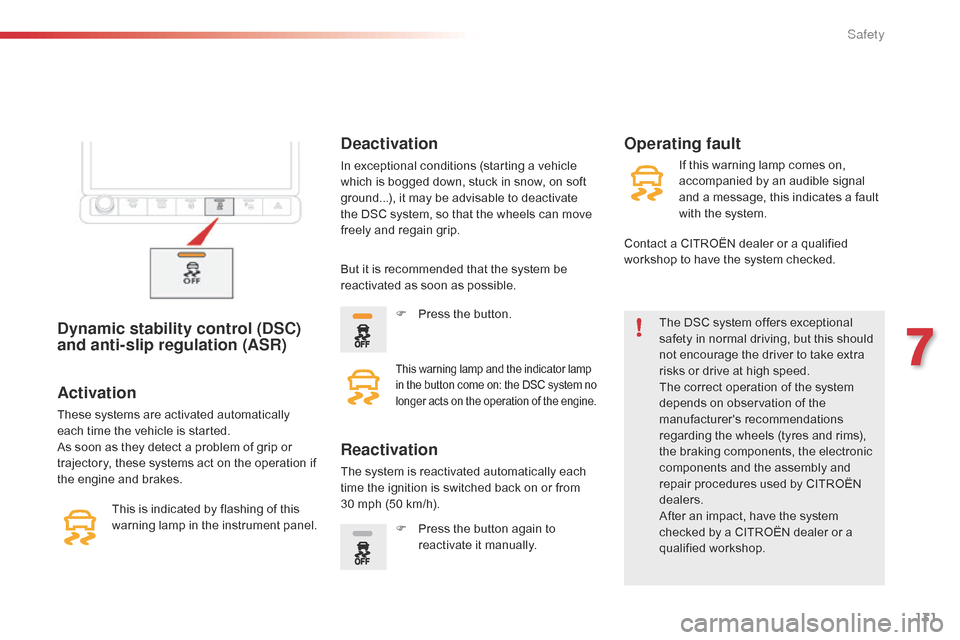
131
Dynamic stability control (DSC)
and anti-slip regulation (ASR)The DSC system offers exceptional safety in normal driving, but this should
n
ot encourage the driver to take extra
r
isks or drive at high speed.
The
correct operation of the system
d
epends on observation of the
ma
nufacturer's
r
ecommendations
r
egarding the wheels (tyres and rims),
t
he braking components, the electronic
c
omponents and the assembly and
r
epair procedures used by CITROËN
d
ealers.
After
an impact, have the system
c
hecked by a CITROËN dealer or a
q
ualified
w
orkshop.
Activation
These systems are activated automatically each time the vehicle is started.
As
soon as they detect a problem of grip or
t
rajectory, these systems act on the operation if
t
he engine and brakes.
Deactivation
In exceptional conditions (starting a vehicle which is bogged down, stuck in snow, on soft
g
round...), it may be advisable to deactivate
t
he DSC system, so that the wheels can move
f
reely and regain grip.
This
is
indicated
by
flashing
of
this
w
arning
lamp
in
the
instrument
panel.
Operating fault
But it is recommended that the system be r eactivated as soon as possible.
F
P
ress the button.
This warning lamp and the indicator lamp in the button come on: the DSC system no l
onger acts on the operation of the engine.
Reactivation
The system is reactivated automatically each time the ignition is switched back on or from
3
0 mph (50 km/h).
F
P
ress the button again to
r
eactivate it manually. If
this warning lamp comes on,
a
ccompanied by an audible signal
a
nd a message, this indicates a fault
w
ith the system.
Contact a CITROËN dealer or a qualified
w
orkshop to have the system checked.
7
Safety
Page 134 of 326

132
Seat belts
Front seat belts
The front seat belts are fitted with a pretensioning and force limiting system.
This
system improves safety in the front
s
eats in the event of a front or side impact.
D
epending on the severity of the impact, the
p
retensioning system instantly tightens the seat
b
elts against the body of the occupants.
The
pretensioning seat belts are active when
t
he ignition is on.
The
force limiter reduces the pressure of the
s
eat belt on the chest of the occupant, so
improving
their protection.Fastening
F Pull the strap, then insert the tongue in the buc
kle.
F
C
heck that the seat belt is fastened
c
orrectly by pulling the strap.
Unfastening
F Press the red button on the buckle.
F G uide the seat belt as it reels in.
Rear seat belts
The rear seats are each fitted with a three-point seat belt.
Safety
Page 135 of 326

133
From approximately 12 mph (20 km/h), the warning lamp(s)
f
lash for two minutes accompanied
b
y an audible signal. Once these
t
wo minutes have elapsed, the
w
arning lamp(s) remain on until the
d
river or front passenger fastens their
s
eat belt.
Seat belt not fastened /
unfastened warning lamps Front seat belt warning lamps
On switching on the ignition, warning lam
p 1 comes on in the instrument
p
anel and the corresponding warning
l
amp (2
and 3)
comes on in red in
t
he passenger's seat belt and front
a
irbag warning lamp display if the
d
river's seat belt or front passenger's
s
eat belt is not fastened or is
u
nfastened.
1.
F
ront
seat
belts
not
fastened
/
unfastened
w
arning
lamp
in
the
instrument
panel.
2.
F
ront
left
seat
belt
warning
lamp.
3.
F
ront
right
seat
belt
warning
lamp.
4.
R
ear
right
seat
belt
warning
lamp.
5.
R
ear
centre
seat
belt
warning
lamp.
6.
R
ear
left
seat
belt
warning
lamp.
Rear seat belt warning lamps
The corresponding warning
l amp (4 to 6 )
comes on in red in the
s
eat belt and front airbag warning
l
amp display if one or more rear
p
assengers
u
nfasten
t
heir
sea
t
b
elt.
7
Safety
Page 137 of 326
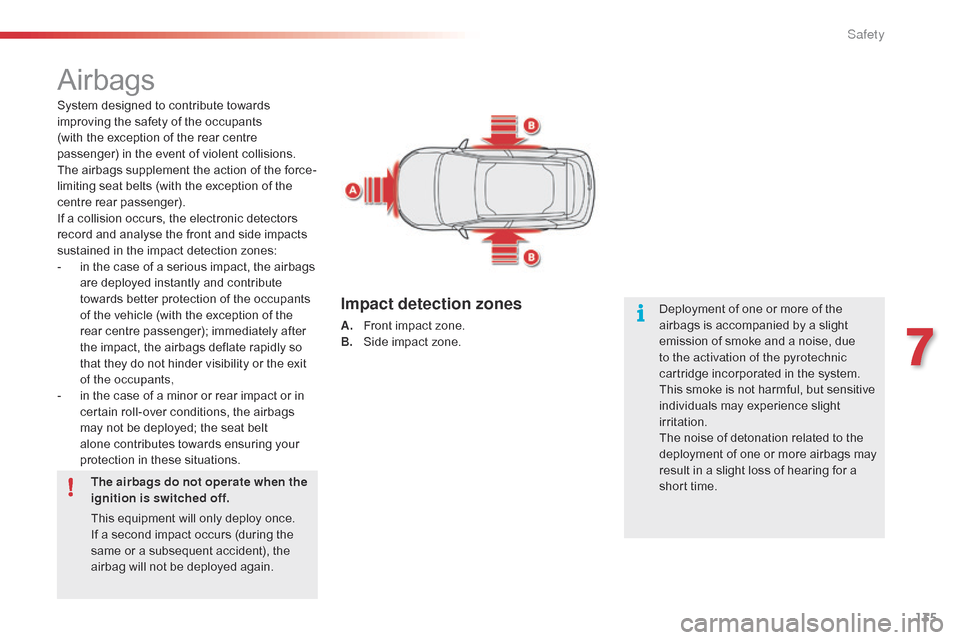
135
Airbags
System designed to contribute towards improving the safety of the occupants
(with
the exception of the rear centre
p
assenger) in the event of violent collisions.
T
he airbags supplement the action of the force-
limiting
seat belts (with the exception of the
c
entre
r
ear
p
assenger).
If
a collision occurs, the electronic detectors
r
ecord and analyse the front and side impacts
s
ustained in the impact detection zones:
-
i
n the case of a serious impact, the airbags
a
re deployed instantly and contribute
t
owards better protection of the occupants
o
f the vehicle (with the exception of the
r
ear centre passenger); immediately after
t
he impact, the airbags deflate rapidly so
t
hat they do not hinder visibility or the exit
o
f the occupants,
-
i
n the case of a minor or rear impact or in
c
ertain roll-over conditions, the airbags
m
ay not be deployed; the seat belt
a
lone contributes towards ensuring your
p
rotection in these situations.
The airbags do not operate when the
ignition is switched off.
This
equipment will only deploy once.
I
f a second impact occurs (during the
s
ame or a subsequent accident), the
a
irbag will not be deployed again. Deployment
of one or more of the
a
irbags is accompanied by a slight
e
mission of smoke and a noise, due
t
o the activation of the pyrotechnic
cartridge
incorporated in the system.
This
smoke is not harmful, but sensitive
i
ndividuals may experience slight
ir
ritation.
The
noise of detonation related to the
d
eployment of one or more airbags may
r
esult in a slight loss of hearing for a
s
hort time.
Impact detection zones
A. Front impact zone.
B. S ide impact zone.
7
Safety